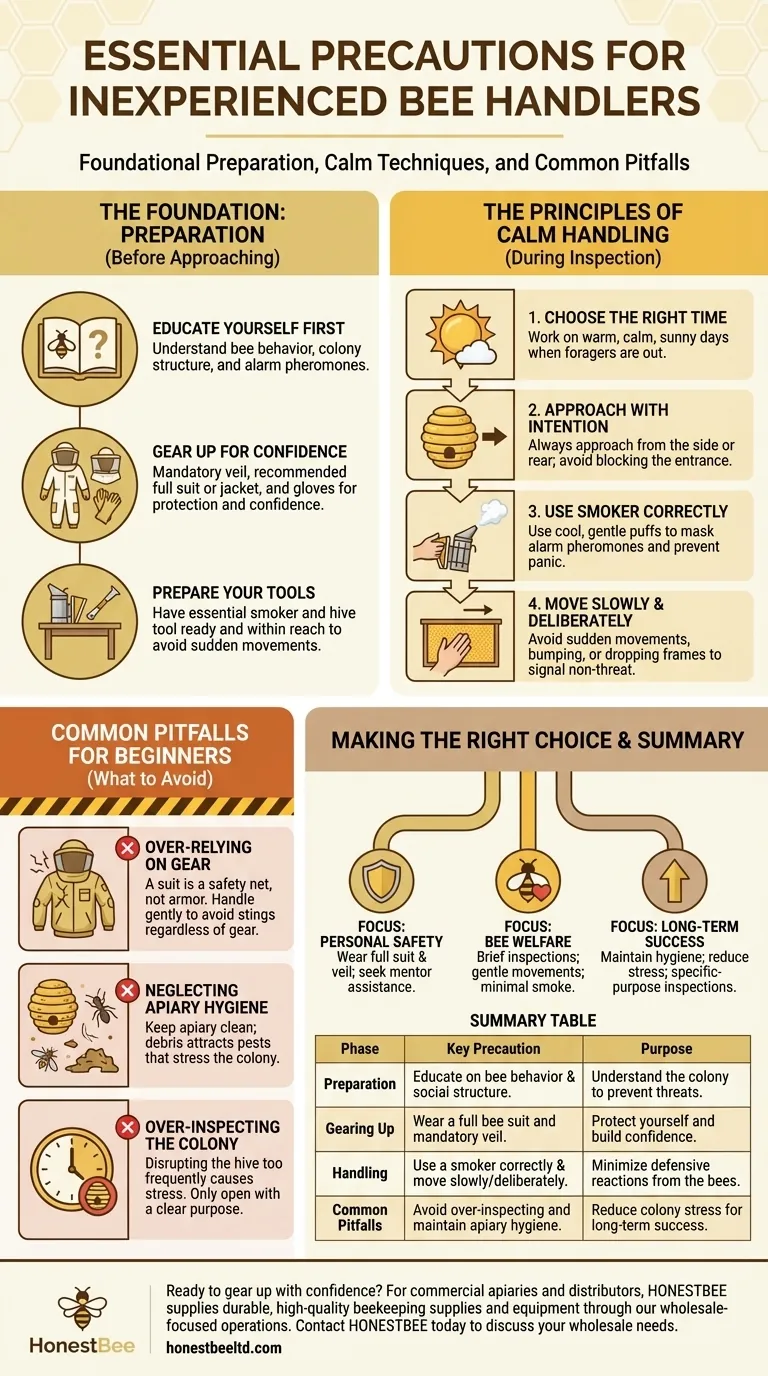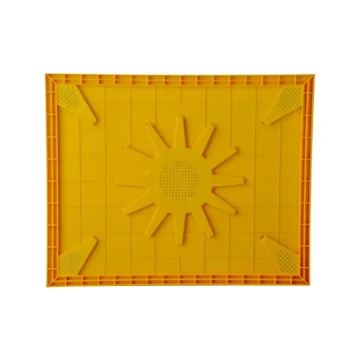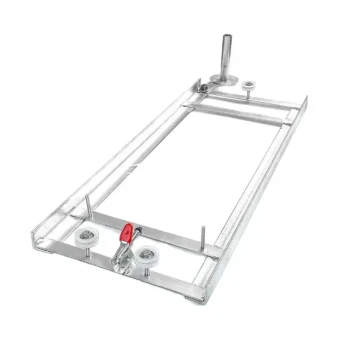For inexperienced individuals handling bees, the most critical precautions involve three distinct phases: educating yourself on bee behavior before you begin, wearing proper protective clothing, and using calm, deliberate techniques when you finally open the hive. This preparation is non-negotiable for the safety of both you and the colony.
The core principle of safe bee handling is not simply to avoid stings, but to understand and respect bee behavior. Your goal is to create a low-stress environment, which in turn minimizes the bees' defensive reactions and ensures your safety.

The Foundation: Preparation Before Approaching the Hive
Your first interaction with the bees begins long before you are standing next to the hive. Thorough preparation is what separates a stressful encounter from a successful inspection.
Educate Yourself First
Before handling bees, you must have a foundational understanding of their world. Learn about the colony's social structure, the roles of different bees, and, most importantly, how they communicate threats through alarm pheromones.
Gear Up for Confidence
Adequate protective clothing is essential. This isn't just about preventing stings; it's about giving you the confidence to move calmly and deliberately.
- A bee veil is mandatory. It protects your face, the most vulnerable and dangerous place to be stung.
- A full bee suit or a jacket-and-veil combination is highly recommended.
- Gloves protect your hands, but be aware they can make you less gentle. Many experienced beekeepers eventually work without them.
Prepare Your Tools
Have all your tools ready and within reach before you approach the hive. Fumbling for a tool mid-inspection can cause abrupt movements that agitate the bees. Your essential tools are a smoker and a hive tool.
The Principles of Calm Bee Handling
Once you are prepared, your actions dictate the colony's response. The goal is to work smoothly and efficiently, like a partner to the bees, not an intruder.
Choose the Right Time
Always work your bees on a warm, calm, sunny day. The majority of forager bees will be out of the hive, meaning fewer bees inside to become defensive. Avoid inspections on cold, windy, or rainy days.
Approach with Intention
Never approach a hive from the front, as you will block the entrance and be perceived as a threat by guard bees. Always approach from the side or the rear.
Use Your Smoker Correctly
A smoker is your most important tool for communication. Cool, white smoke masks the bees' alarm pheromone, preventing a panic signal from spreading throughout the colony. A few gentle puffs at the entrance and under the lid is all that is needed to start.
Move Slowly and Deliberately
All of your movements should be slow, gentle, and intentional. Avoid bumping the hive, dropping frames, or making sudden gestures. Smooth movements signal to the bees that you are not a threat.
Common Pitfalls for Beginners
Understanding what not to do is as important as knowing what to do. Avoiding these common mistakes will prevent most negative experiences.
Over-relying on Your Gear
Your bee suit is a safety net, not a suit of armor. It does not give you permission to be rough or careless. The goal is to handle the bees so gently that you wouldn't get stung even without a suit.
Neglecting Apiary Hygiene
A messy bee yard invites problems. Leaving old feeding debris, wax comb, or empty containers lying around can attract pests like wasps, ants, or small hive beetles. These pests put the colony under stress, which can make them more defensive and difficult to handle.
Over-Inspecting the Colony
Every time you open a hive, you disrupt the colony's carefully controlled environment. Inexperienced beekeepers are often tempted to look inside too frequently. Only perform inspections with a clear purpose in mind.
Making the Right Choice for Your Goal
Your approach should align with your primary objective. Use these guidelines to focus your efforts.
- If your primary focus is personal safety: Always wear a full bee suit and veil, and consider having an experienced mentor with you for your first few inspections.
- If your primary focus is bee welfare: Keep your inspections as brief as possible, move with gentle precision, and only use your smoker as much as necessary to keep the bees calm.
- If your primary focus is long-term success: Maintain a clean and organized apiary to reduce colony stress and only open the hive when you have a specific question to answer or task to perform.
By prioritizing preparation and a calm demeanor, you build the confidence and skill needed for a safe and rewarding beekeeping experience.
Summary Table:
| Phase | Key Precaution | Purpose |
|---|---|---|
| Preparation | Educate on bee behavior & social structure. | Understand the colony to prevent threats. |
| Gearing Up | Wear a full bee suit and mandatory veil. | Protect yourself and build confidence. |
| Handling | Use a smoker correctly & move slowly/deliberately. | Minimize defensive reactions from the bees. |
| Common Pitfalls | Avoid over-inspecting and maintain apiary hygiene. | Reduce colony stress for long-term success. |
Ready to gear up with confidence?
For commercial apiaries and distributors, having the right equipment is the first step to safe and efficient beekeeping. HONESTBEE supplies durable, high-quality beekeeping supplies and equipment through our wholesale-focused operations.
Contact HONESTBEE today to discuss your wholesale needs and ensure your team is prepared for success.
Visual Guide

Related Products
- Mesh Ventilated 3 Layer Goatskin Beekeepers Gloves for Beekeeping
- Professional Galvanized Hive Strap with Secure Locking Buckle for Beekeeping
- Nicot Queen Rearing Kit for Beekeeping and Grafting in Nicot System
- Versatile Ratchet Hive Strap with S-Hooks for Secure Fastening
- Jenter Queen Rearing Kit Complete Set for Bee Breeding
People Also Ask
- Why is it important to have gloves available even if not always worn? Essential Risk Management for Beekeepers
- What should be considered when selecting beekeeping gloves? Find the Perfect Fit for Safety & Dexterity
- How do beekeeping gloves increase comfort during long sessions? Enhance Focus and Reduce Fatigue
- Why do some beekeepers choose not to wear protective gear? Experience vs. Dexterity in Hive Management
- What are the key considerations for the fit of beekeeping gloves? Ensure Dexterity & Safety



















